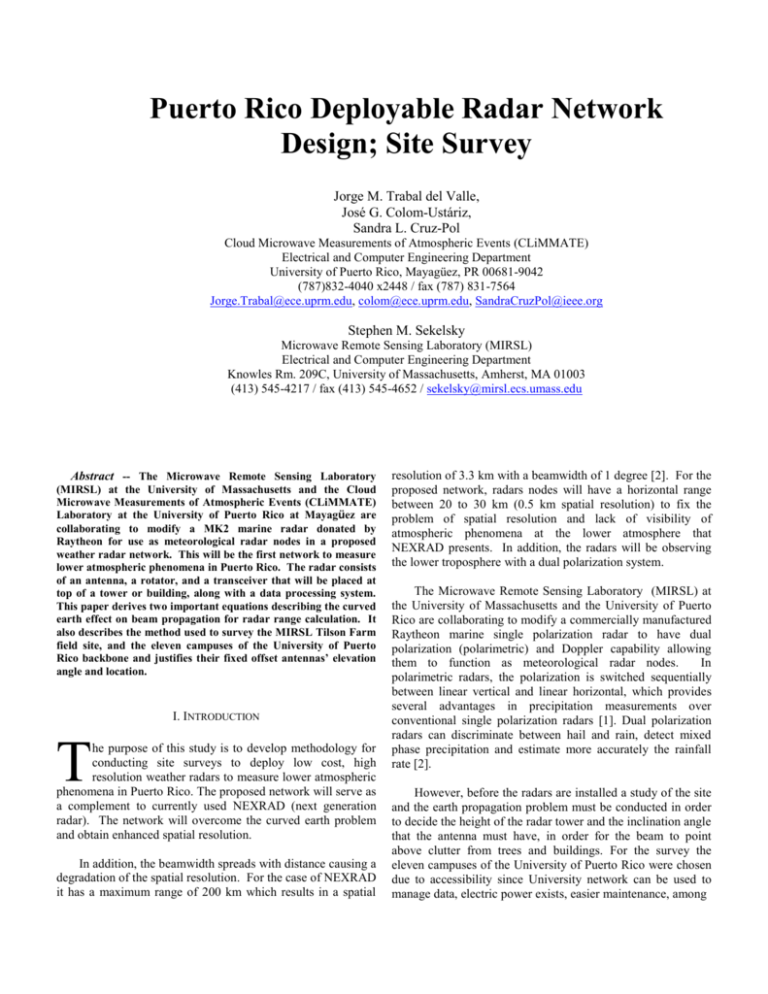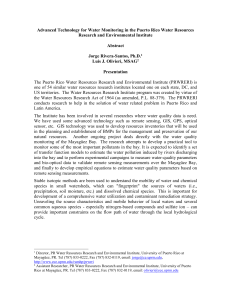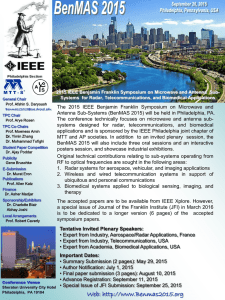igarss03Trabal - Electrical and Computer Engineering Department
advertisement

Puerto Rico Deployable Radar Network Design; Site Survey Jorge M. Trabal del Valle, José G. Colom-Ustáriz, Sandra L. Cruz-Pol Cloud Microwave Measurements of Atmospheric Events (CLiMMATE) Electrical and Computer Engineering Department University of Puerto Rico, Mayagüez, PR 00681-9042 (787)832-4040 x2448 / fax (787) 831-7564 Jorge.Trabal@ece.uprm.edu, colom@ece.uprm.edu, SandraCruzPol@ieee.org Stephen M. Sekelsky Microwave Remote Sensing Laboratory (MIRSL) Electrical and Computer Engineering Department Knowles Rm. 209C, University of Massachusetts, Amherst, MA 01003 (413) 545-4217 / fax (413) 545-4652 / sekelsky@mirsl.ecs.umass.edu Abstract -- The Microwave Remote Sensing Laboratory (MIRSL) at the University of Massachusetts and the Cloud Microwave Measurements of Atmospheric Events (CLiMMATE) Laboratory at the University of Puerto Rico at Mayagüez are collaborating to modify a MK2 marine radar donated by Raytheon for use as meteorological radar nodes in a proposed weather radar network. This will be the first network to measure lower atmospheric phenomena in Puerto Rico. The radar consists of an antenna, a rotator, and a transceiver that will be placed at top of a tower or building, along with a data processing system. This paper derives two important equations describing the curved earth effect on beam propagation for radar range calculation. It also describes the method used to survey the MIRSL Tilson Farm field site, and the eleven campuses of the University of Puerto Rico backbone and justifies their fixed offset antennas’ elevation angle and location. I. INTRODUCTION T he purpose of this study is to develop methodology for conducting site surveys to deploy low cost, high resolution weather radars to measure lower atmospheric phenomena in Puerto Rico. The proposed network will serve as a complement to currently used NEXRAD (next generation radar). The network will overcome the curved earth problem and obtain enhanced spatial resolution. In addition, the beamwidth spreads with distance causing a degradation of the spatial resolution. For the case of NEXRAD it has a maximum range of 200 km which results in a spatial resolution of 3.3 km with a beamwidth of 1 degree [2]. For the proposed network, radars nodes will have a horizontal range between 20 to 30 km (0.5 km spatial resolution) to fix the problem of spatial resolution and lack of visibility of atmospheric phenomena at the lower atmosphere that NEXRAD presents. In addition, the radars will be observing the lower troposphere with a dual polarization system. The Microwave Remote Sensing Laboratory (MIRSL) at the University of Massachusetts and the University of Puerto Rico are collaborating to modify a commercially manufactured Raytheon marine single polarization radar to have dual polarization (polarimetric) and Doppler capability allowing them to function as meteorological radar nodes. In polarimetric radars, the polarization is switched sequentially between linear vertical and linear horizontal, which provides several advantages in precipitation measurements over conventional single polarization radars [1]. Dual polarization radars can discriminate between hail and rain, detect mixed phase precipitation and estimate more accurately the rainfall rate [2]. However, before the radars are installed a study of the site and the earth propagation problem must be conducted in order to decide the height of the radar tower and the inclination angle that the antenna must have, in order for the beam to point above clutter from trees and buildings. For the survey the eleven campuses of the University of Puerto Rico were chosen due to accessibility since University network can be used to manage data, electric power exists, easier maintenance, among other advantages. III. SURVEY MATERIALS AND PROCEDURE Mathematical relationships to describe the curved earth problem and analysis of survey data from the eleven campuses of the University of Puerto Rico field site will be discussed. II. CURVED EARTH EFFECT The earth’s curvature affects the range and hides some scatterers from the radar beam or footprint area [3]. To solve that problem a sketch was created with all the wave propagation, distance parameters, and earth curvature effects (Fig 1). In each campus, the location of the radar was selected on the tallest building in order to get an obstruction free view angle. To determine the height and fixed elevation offset of the antenna we measured the minimum elevation angle over a full 360 degree azimuth swath (in 5 degree increments from North to West) using a distance range meter telescope, a digital level, and a compass. The geographic coordinates were obtained using a Global Positioning System (GPS). IV. PRELIMINARY RESULTS AND DISCUSSION In the diagram h1 is the perpendicular distance from the earth to the radar horizontal range, and h2 is the distance (aligned with the Earth’s radius D/2 and with h1) between R and radar beam and D is the Earth’s diameter (12756.272 km). Parameters h1 and h2 were derived working with the geometry of the problem and we obtained, h1 h2 4 R ( 2 H D) 2 D 2 R sin( ) 4 R 2 ( D 2 H ) 2 ( D 2 H ) cos( ) 2 R sin( ) (1) (2) It is easy to observe from the equations that both depend on the antenna height H, the earth’s diameter D and the radar range distance R. We can also notice that h2 depends on The h1 equation does not depend on because it does not take the antenna tilt angle into consideration. Figure 2 depicts a plot of minimum obstruction angle vs. azimuth angle with its respective 360 degree swath panorama. One was made for each of the eleven campuses. It can be noticed from the plot that some minimum angles are required to surpass the obstructions. In the Puerto Rico case the far hills establish the minimum antenna vertical angle for each campus. The radar range can be obtained for each campus by plotting the sum of equations 1 and 2 with respect to horizontal distance (Fig. 3). The plot has two curves with the one in solid having no antenna height and tilted and the dashed one with antenna height over sea level and the same tilt angle (θ). Looking at this plot you can determine at what height from the earth the radar beam will be at a specific distance or range point from the antenna. It can also be observed that the two curves behave like one curve after a significant distance. The point where the height of the radar beam is at 4 km was marked on the plot to identify the height where the ice layer starts and consequentially establishing the maximum range distance. Mayagüez Campus Survey Site Panorama Figure 1. Curved earth problem for weather radar Figure 2. Mayagüez Campus Survey Data V. CONCLUSIONS AND FUTURE PLANS The procedure to survey the eleven campuses of the University of Puerto Rico was explained, resulting in the coverage depicted in Figure 4. From the figure we can observe that using six (Aguadilla, Arecibo, Humacao, Mayagüez, Ponce, Rio Piedras) of the eleven campuses there is full coverage of the island. The circles are shown using the maximum range of the radars, which exceeds the 30 km required to obtain good spatial resolution. If a radar range of 30 km was used, more radars would be needed to obtain a complete coverage of the Island. Figure 3. Combined effect of curved earth and tilted beam (Mayagüez Campus) As a preliminary result, Table 1 summarizes the data of the eleven campuses. It shows the antenna minimum vertical angle, height, and the maximum radar range distance. A map of Puerto Rico with the eleven campus sites is also shown in Fig. 4. The red points (Cayey, Carolina, Utuado) mean that a radar in that point will be not feasible because of the high antenna tilt angle required to surpass the obstacles, while Bayamón and Medical Sciences campuses are in red because Rio Piedras Campus will cover the area and they will cause unnecessary overlapping. The circles have a radius of the maximum range shown in the Table 1. TABLE 1 SURVEY RESULTS Site Minimum Vertical Angle (Degrees) Aguadilla 4 Arecibo 5 Bayamón 5 Carolina 14.1 Cayey 16 Humacao 6 Mayagüez 4.8 Medical Sciences 3.5 Ponce 5.2 Rio Piedras 3.3 Utuado 11.3 Antenna Height Over Sea Level (Feets) 171 71 282 177 230 219 238 1384 643 295 207 Figure 4. Deployable radar network Maximum Radar Range (Km) 52 44 44 15.5 13.5 37 46 60.5 42 62 19.5 The first kilometer of the atmosphere, for which an angle of one to two degrees is needed, is of interest in the design of the network. Due to the geography of the island, the vertical angles required to exceed the hills are very high, which leads us to find higher locations to reduce these angles. As a future work new sites with more height will be surveyed to reduce the minimum antenna vertical angle with the purpose of the observation of the lowest part of the atmosphere. Also the Raytheon marine radar rotator, transceiver, and antenna will be installed and the data processing system will be designed for testing purposes. ACKNOWLEDGMENTS This research is made possible thanks to the support of NASA Tropical Center for Earth and Space Studies (TCESS), NASA Faculty Award for Research in Cloud Microwave Measurements of Atmospheric Events (FAR-Climmate) and the NASA Partnership for Spatial and Computational Research (PaSCoR) at University of Puerto Rico, Mayagüez Campus and in collaboration with the Microwave Remote Sensing Laboratory at University of Massachusetts Amherst. REFERENCES 1. D. S. Zrnic, "Simultaneous differential polymetric measurements and copolar correlation coefficient measurements", United States Patent 5,500,646, 1996. 2. R. J. Doviak, D. S. Zrnic, "Doppler radar and weather observations", 2nd ed. San Diego, CA. Academic Press, 1993. 3. M. I. Skolnik, "Introduction to radar systems", 3rd ed. New York, NY. McGraw-Hill, 1980. 4. V. N. Bringi, V. Chandrasekar, "Polarimetric Doppler weather radar principles and applications", Cambridge, UK. Cambridge University Press, 2001




